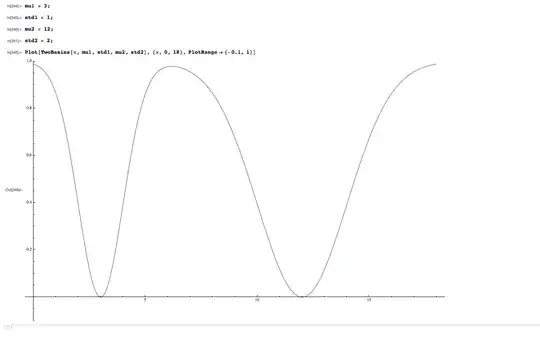I wanted to find the critical points of the (simple!) equation:
$$ B(w; \mu_1, \sigma_1, \mu_2, \sigma_2 ) = 1 - e^{ - \beta_1 (w - \mu_1)^2 } - e^{ - \beta_2 (w - \mu_2)^2}$$
Where $\beta_i = \frac{1}{2 \sigma^2_i}$ usually called the precision parameter of the Gaussian or RBF. Anyway, what I wanted in particular to solve is:
$$ B'(w; \mu_1, \sigma_1, \mu_2, \sigma_2 ) = - \beta_1 (w-\mu_1) e^{ - \beta_1 (w - \mu_1)^2 } - \beta_2(w - \mu_2)e^{ - \beta_2 (w - \mu_2)^2} = 0$$
looking at the equation above I can't seem to find an easy way to make it zero. To make the first term zero we can choose $w = \mu_1 $ but that doesn't make the second term zero. Similarly, the other way round. However, it is super intuitively obvious that there are 2 minimums and 1 maximum since there are two dips defined by the upside down Gaussian (and in between them some maximum). I plotted this in mathematica to confirm that there must be these critical points and it seems I am correct:
however surprisingly I cannot find an easy way to express the critical points analytically. My initial goal is to at least have a way to express these 3 critical points for this 1 dimensional example if ever want to hope to find the critical points for higher dimensions.
Anyone knows how to do this?
My real intention is to be able to programmatically/systematically get the x-axis value between the two minimums that has exactly gradient equal to zero. Ideally able to generalize in higher dimensions.
For 1D and 2D I can sort of eye ball what the value should be by plotting things and then asking mathematics to tell me which value of $x$ leads to $\nabla f'(x) = 0$.
